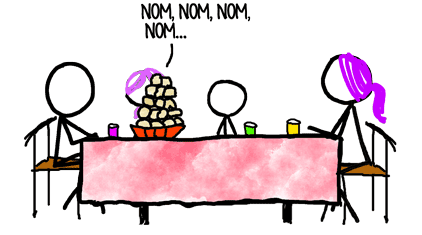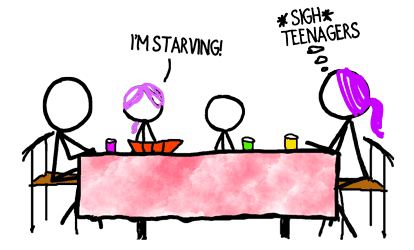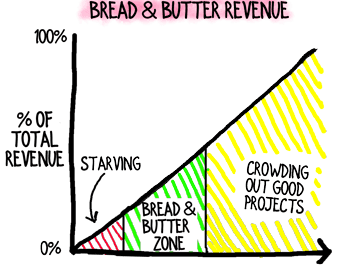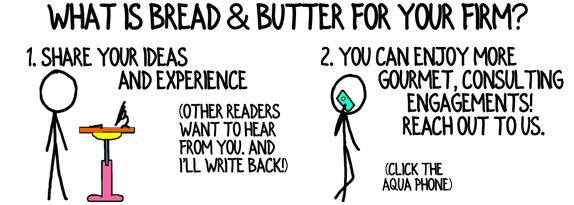Bread & Butter Projects: What They Are and Why Your Consulting Firm Needs Them
At virtually every restaurant, waitstaff plunks down some variation of bread and butter soon after you’re seated.
The same pros and cons of that starchy pre-appetizer ring true for your consulting firm, which is why every successful consulting firm includes “bread & butter” projects in their diet.
When you’re dining out, a steaming hot roll suppresses angry growls from your stomach while you contemplate the menu.
However, without a bit of willpower, you (or your kids) will stuff yourself on the easy-to-reach carbs and fat, leaving no room for the healthier, more delectable items on the menu.

Similarly, your consulting firm’s bread & butter projects consist of engagements that are easy, inexpensive and plentiful. They keep the lights on and your team employed through the normal ups and downs of consulting revenue.
If you fail to maintain a steady supply of bread & butter projects, your consulting firm’s revenue swings will be wider and the risks to your firm, your team and your morale are higher.
On the flip side (of the cracker), if your consulting firm loads up on bread & butter projects, you won’t have capacity to win high-margin, capability-stretching engagements.
What is your consulting firm’s bread & butter project?
Probably what you considered center-of-plate engagements a few years ago. Every firm’s bread & butter is different, and yours will change over time as you grow, elevate your offerings and raise your minimum fees. Today’s artisan loaf is tomorrow’s day-old croutons.
Your Firm’s Bread & Butter
Find your consulting firm’s bread & butter by identifying projects that fit three criteria:
- High demand (i.e., a pervasive problem)
- Easy to deliver, without high levels of expertise or experience
- Relatively low fee
Bread & butter projects are likely to be fairly commoditized and competitive and, therefore, margins tend to be lower than ideal.
Importantly, bread & butter is lower-end work than your standard fare, not lower fees for your core offerings.
Always include bread & butter work in your consulting firm’s revenue mix, even when you have plenty of demand for your higher margin projects. If you don’t have it built into your plan yet, pencil in at least 20% of your revenue coming from bread & butter engagements.
That’s enough to stave off hunger and prevent scrounging for work when your pipeline is thin.

Conversely, don’t heap your plate with bread & butter. Too much basic work will crowd out your opportunities to take on highly lucrative, business-building projects.
Keep bread & butter work under 50% of your annual capacity and never let it fill your schedule so much that you can’t take on a demanding, high-margin project.

What is your firm’s bread & butter work?
Post your thoughts in the comment section below—that will help other readers understand the variety of work they could consider as bread & butter for their firms.
Text and images are © 2024 David A. Fields, all rights reserved.

 David A. Fields Consulting Group
David A. Fields Consulting Group 

Be curious to hear from other solopreneurs, for me there is work or no work, so this idea of PB&J work is intriguing.
Bill, think about the work you did ten years ago or that an entry-level person just getting into your field would do. It may be work you’ve never even considered selling before because it doesn’t require anything near your current skill set. That can be your bread & butter work (whether or not you add the peanuts and the jelly 😉).
I appreciate you voicing your question, Bill!
Interesting thought David yet I grapple with the time to “market” the “old” skills/services vs trying to invest the time to find the new work using newer skills/services now available. That whole “balance” thing, if only the 24 hours/day could all be used to focus! 🙂
You typically don’t market your bread & butter projects aggressively, Bill. Instead you let it be known that you do that type of work also. Core work and Bread & Butter work shouldn’t be so different that a prospect is utterly surprised you offer it.
Maintaining a narrow focus is difficult. Especially for those of us who are easily distrac–chocolate!
Great questions and pushback, Bill.
I think my “bread & butter” offering would be my Marketing Strategy Power Hour. It’s low cost and low commitment and gives my audience the ability to get a sense for how I approach marketing, while also giving them a tangible marketing plan outline specifically customized for their business. (This gives them clarity and focus!)
Outstanding example, Kristi. As long as there’s high demand for that offering, so that you can keep a steady 20% or so of your revenue from Power Hour projects, that could be an excellent, Bread & Butter offering.
I appreciate your contributing to the discussion, Kristi!
My bread and butter is SAP transformation projects/guidance or other system implementations. Always need extra hands. Unfortunately take up a lot of time. My high margin is process improvement around the finance areas.
That sounds good, Diane. Ideally, Bread & Butter should not be time consuming. If it eats up more than 50% of your capacity, that’s problematic. As we elevate our skills we can (sometimes) complete Bread & Butter work more efficiently. With AI tools, there’s even more opportunity to streamline.
Thank you for the example, Diane!
Hi David – new to your blog and so glad to have found you! I’m a solopreneur and mom of two young kids. I left my nonprofit executive role 3 years ago with the goal of building a 6-figure business that can be operated within school hours! I’ve reached the low-end of that goal through a combination of sub-contracting with larger firms, independent consulting, jelly beans (my chocolate alternative). Now working to build a more streamlined, higher fee version 2.0.
There are a few things people come to me for that I feel like I’ve “outgrown”. I’ve been wrestling with whether to “turn off” these services as they often drain my energy (boring) or compete for mental space/time when bigger, more interesting projects come along. Now I think I could recast them as bread and butter. For example: impact/annual reports (they take a while, but pay well and are easy to do in the off-hours when kids are asleep/occupied), short-term strategic planning (e.g. a weekend strategic planning retreat for <$5K as opposed to a longer org assessment and planning process for $25K+) and short communications, change management, revenue growth coaching sessions/roadmaps for folks who are not ready (yet!) to pay for larger projects or retainer-based offerings.
I have 20-years of experience in my field (public sector, social impact and cultural sector work, with expertise in areas like leadership, marketing, communications, change management, government relations, revenue growth). I often struggle with clarity/focus in my business. There are a lot of things I can do and a lot of my work has come through referrals and networks that are focused on what I’ve done in the PAST. Maybe the bread and butter model can help me in that way, too – taking advantage of my skills and track record, but putting some boundaries in place so my practice has room to grow?
Welcome to this (very generous) community, Erica. Other readers and I are glad you’re here and that you’re contributing! Thank you also for sharing your situation, and congratulations on starting up your practice.
You’re looking at Bread & Butter exactly right. those smaller reports, etc. can be kept at a low level–maybe 10-20% of your capacity, and keep in mind that today’s bigger, $25k project, is tomorrow’s Bread & Butter!
Re clarity, you’ve brought up an interesting idea. I don’t know of anyone who has used Bread & Butter to help them gain focus; however, your push to focus your firm is well-placed. The more (and sooner) you develop focus, the easier time you’ll have growing and sustaining your practice.
Thanks again for joining in the conversation, Erica!
Very interesting. Recently got intuitive guidance not to seek out B&B projects, and reading this I know why. At my level it would risk commoditizing my work, and my Positive Leadership Application Systems are very powerful, 30 yr track record w/exec. teams, and require deep skills. All based on pioneering Ph.D. dissertation on appreciation as the basis of all leadership and org. transformation, for which I was fired from my rent and food money part time consulting job and laughed out of the room by academics. But clients were transformed in minutes so I stuck with them and ignored naysayers.
Aha! Thanks much. Making peace with waiting until my new systems manuals roll out. Always good to see what you catalyze, David!
Linne, there’s nothing wrong with conducting some commoditized work. You don’t offer the crown jewels, of course–they’re not Bread & Butter. It could be that the work other than your new system is your Bread & Butter. Or, perhaps your new system will become your Bread & Butter while you develop the next level of even higher impact approaches.
Thanks for sharing your story, Linne!